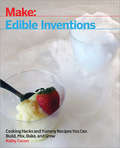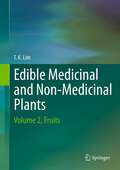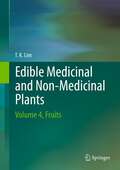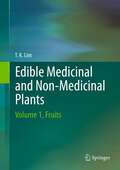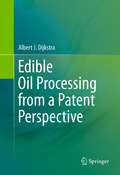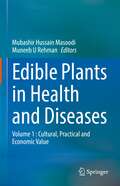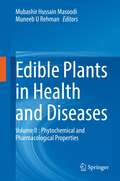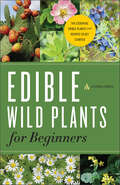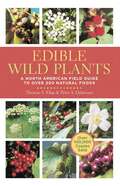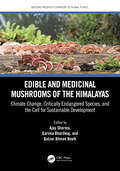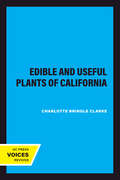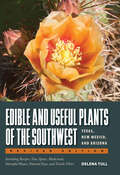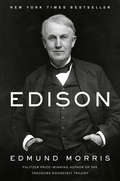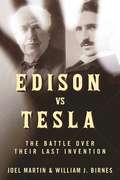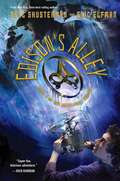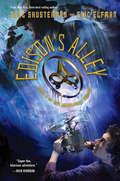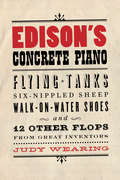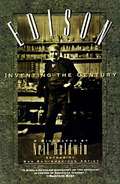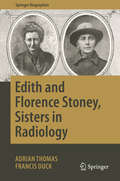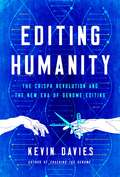- Table View
- List View
Edible Inventions: Cooking Hacks and Yummy Recipes You Can Build, Mix, Bake, and Grow
by Kathy CeceriBelieve it or not, there's a lot of inventing going on in the kitchen. Unless you only eat fruits and veggies right off the plant, you are using tools and techniques invented by humans to make food more tasty and easier to digest. When you cook food, you start to break it down into a form your body can absorb. When you add chemicals to make it thicker, gooey-er, or puffy-er, you turn a bunch of boring ingredients into a mouth-watering snack. Edible Inventions: Cooking Hacks and Yummy Recipes You Can Build, Mix, Bake, and Grow will show you some unusual ways to create a meal, and help you invent some of your own. Projects include:3D printing with foodChemical cuisine and molecular gastronomyPrepared foods like jellies and pickles at homeGrowing your own ingredientsCooking off the grid
Edible Medicinal And Non Medicinal Plants
by Lim T. K.This book continues as volume 3 of a multi-compendium on Edible Medicinal and Non-Medicinal Plants. It covers edible fruits/seeds used fresh or processed, as vegetables, spices, stimulants, edible oils and beverages. It encompasses species from the following families: Ginkgoaceae, Gnetaceae, Juglandaceae, Lauraceae, Lecythidaceae, Magnoliaceae, Malpighiaceae, Malvaceae, Marantaceae, Meliaceae, Moraceae, Moringaceae, Muntigiaceae, Musaceae, Myristicaceae and Myrtaceae. This work will be of significant interest to scientists, researchers, medical practitioners, pharmacologists, ethnobotanists, horticulturists, food nutritionists, agriculturists, botanists, conservationists, lecturers, students and the general public. Topics covered include: taxonomy; common/English and vernacular names; origin and distribution; agroecology; edible plant parts and uses; botany; nutritive and pharmacological properties, medicinal uses and research findings; nonedible uses; and selected references.
Edible Medicinal And Non-Medicinal Plants
by T. K. LimThis book continues as volume 4 of a multi-compendium on Edible Medicinal and Non-Medicinal Plants. It covers edible fruits/seeds used fresh or processed, as vegetables, spices, stimulants, edible oils and beverages. It encompasses selected species from the following families: Fagaceae, Grossulariaceae, Hypoxidaxeae, Myrsinaceae Olacaceae, Oleaceae, Orchidaceae, Oxalidaceae, Pandanaceae, Passifloraceae, Pedaliaceae, Phyllanthaceae, Pinaceae, Piperaceae, Rosaceae and Rutaceae . This work will be of significant interest to scientists, researchers, medical practitioners, pharmacologists, ethnobotanists, horticulturists, food nutritionists, agriculturists, botanists, conservationists, lecturers, students and the general public. Topics covered include: taxonomy; common/English and vernacular names; origin and distribution; agroecology; edible plant parts and uses; botany; nutritive and pharmacological properties, medicinal uses and research findings; nonedible uses; and selected references.
Edible Medicinal and Non-Medicinal Plants: Volume 1, Fruits
by Lim T. K.This multi-compendium is a comprehensive, illustrated and scientifically up-to-date work covering more than a thousand species of edible medicinal and non-medicinal plants. This work will be of significant interest to scientists, researchers, medical practitioners, pharmacologists, ethnobotanists, horticulturists, food nutritionists, agriculturists, botanists, herbalogists, conservationists, teachers, lecturers, students and the general public. Topics covered include: taxonomy (botanical name and synonyms); common English and vernacular names; origin and distribution; agro-ecological requirements; edible plant part and uses; botany; nutritive and medicinal/pharmacological properties, medicinal uses and current research findings; non-edible uses; and selected/cited references. Each volume covers about a hundred species arranged according to families and species. Each volume has separate scientific and common names indices and separate scientific and medical glossaries.
Edible Oil Processing from a Patent Perspective
by Albert J. DijkstraPatent literature has always been a mine of information, but until recently, it was difficult to access. Now, with the Internet, access to all patent documents is almost instantaneous and free. However, interpreting the technical information provided by patent literature requires a certain skill. This monograph aims to provide that skill by explaining patent jargon and providing background information on patenting. Patents dealing with edible oil processing are used to explain various aspects of patenting. To make the explanations less impersonal, some have been larded with personal remarks and experiences. Accordingly, this monograph is intended for scientists and engineers dealing with edible oils and fats who want to extend their sources of technical information. Hopefully, it will inspire them to innovate, help them to avoid duplication, and provide them with some amusement.
Edible Plants in Health and Diseases: Volume 1 : Cultural, Practical and Economic Value
by Mubashir Hussain Masoodi Muneeb U RehmanThe book provides significant information on some of the promising edible medicinal plants and how these possess both nutritive as well as medicinal value. The significance of these edible plants in traditional medicine, their distribution in different regions and the importance of their chemical constituents are discussed systematically concerning the role of these plants in ethnomedicine in different regions of the world. The current volume focuses on the economic and culturally important medicinal uses of edible plants and a detailed survey of the literature on scientific researches of pharmacognostical characteristics, traditional uses, scientific validation, and phytochemical composition, and pharmacological activities. This book is a single-source scientific reference to explore the specific factors that contribute to these potential health benefits, as well as discussing how to maximize those potential benefits. Chemists, food technologists, pharmacologists, phytochemists as well as all professionals involved with quality control and standardization will find in this book a valuable and updated basis for their work.
Edible Plants in Health and Diseases: Volume II : Phytochemical and Pharmacological Properties
by Mubashir Hussain Masoodi Muneeb U RehmanThe book provides essential information on some of the promising edible medicinal plants and how these possess both nutritional as well as therapeutic value. The significance of the edible plants in traditional medicine and the importance of the distribution of their chemical constituents are discussed systematically concerning the role of these plants in ethnomedicine in different regions of the world. The current volume deals with the individual plants' phytochemical and pharmacological properties, emphasizing human health. The title would demonstrate the value of natural edible plants and introduce readers to state-of-the-art developments and trends in omics-driven research. This book is a single-source scientific reference to explore the specific factors that contribute to these potential health benefits and discuss how to maximize those potential benefits. Chemists, food technologists, pharmacologists, phytochemists, and all professionals involved with quality control and standardization will find in this book a valuable and updated basis for their work.
Edible Wild Plants for Beginners: The Essential Edible Plants and Recipes to Get Started
by Althea PressDig up a whole new culinary world with this New York Times best-selling field guide to foragingMost of us "forage" for food in the aisles of well-lit grocery stores. But there are delicious edible plants for the taking right outside your door! This all-in-one reference shows you how to identify 31 of the most common edible wild plants in North America, from California to Connecticut.Gather your gear—Dive into edible plant history and foraging FAQs, and learn what tools you'll need before you head out.Spot the snacks—Find photos, descriptions, distinguishing characteristics, and common uses for 31 edible wild plants—from arrowroot to wild rose.Recipes and remedies—Learn to use wild plants in everything from curry and cookies to bug bite balm and bath soaks.Stay safe—This book includes foraging guidelines that are vital to your safety. It's recommended you read it in its entirety before you explore.Make the most of what Mother Nature has to offer with Edible Wild Plants for Beginners.
Edible Wild Plants: A North American Field Guide to Over 200 Natural Foods
by Thomas Elias Peter DykemanPlanning an outdoor adventure? Make sure to consult this information-packed and photo-filled North American field guide—arranged by season and region—before you go! <p><p> Already a huge success in previous editions, this must-have field guide now features a fresh new cover, as well as nearly 400 color photos and detailed information on more than 200 species of edible plants all across North America. <p><p> With all the plants conveniently organized by season, enthusiasts will find it very simple to locate and identify their desired ingredients. Each entry includes images, plus facts on the plant’s habitat, physical properties, harvesting, preparation, and poisonous look-alikes. The introduction contains tempting recipes and there’s a quick-reference seasonal key for each plant.
Edible and Medicinal Mushrooms of the Himalayas: Climate Change, Critically Endangered Species, and the Call for Sustainable Development (Natural Products Chemistry of Global Plants)
by Ajay Sharma Gulzar Ahmad Nayik Garima BhardwajThis book, as part of the “Natural Products Chemistry of Global Plants” series, describes in detail the health-promoting wild edible and medicinal mushrooms specific to the Himalayas region. The focus of the book is to draw on the rich culture, folklore, and environment of the Upper Himalayas, which represents a scientifically significant region. The Himalayas has rich plant resources and a large diversity of plants and mushrooms, which can provide important health benefits as detailed throughout the text. Drawing attention to these mushrooms with detailed scientific descriptions may help in the awareness and in developing sustainable growth of these important resources. Features Provides an opportunity to describe the wild edible and medicinal mushrooms from this scientifically significant region. Represents a wider variety of mushrooms than previously published in other books. Presents more content related to traditional uses, phytochemistry, pharmacology, distribution, processing, toxicology, conservation, and future prospective of individual mushrooms. The plants and mushrooms of the region are valuable resources not only to local populations but to those living outside the region. Scientists are monitoring the rich Himalayan plant resources and the consequences of climate change on this precarious ecosystem.
Edible and Useful Plants of California (California Natural History Guides #41)
by Charlotte Bringle ClarkeBoth American Indians and the pioneers knew and used many different plant species-for food, fibers, medicine, tools, and other purposes. This unique book is a guide to identifying more than 220 such plants. But it goes much further-it also tells the reader how to prepare, cook, and otherwise use them. Some of the dishes for which recipes are given have won culinary prizes. All have been tested not only by the author but also by her students and by journalists-who have been uniformity surprised and impressed.The plants are organized by habitat communities. Description, photos, drawings, and distribution information are given. Where poisonous look-alikes exist, they too are illustrated. Much fascinating information about Indian uses of native and introduced species is included. The author emphasizes conservation considerations; the aim of the book is to educate the reader about intriguing uses of the plants, and to tell how to gather and use the most palatable and abundant species without damaging the environment.
Edible and Useful Plants of the Southwest: Texas, New Mexico, and Arizona
by Delena TullA guide to useful Southwestern wild plants, including recipes, teas, spices, dyes, medicinal uses, poisonous plants, fibers, basketry, and industrial uses.All around us there are wild plants useful for food, medicine, and clothing, but most of us don&’t know how to identify or use them. Delena Tull amply supplies that knowledge in this book, which she has now expanded to more thoroughly address plants found in New Mexico and Arizona, as well as Texas.Extensively illustrated with black-and-white drawings and color photos, this book includes the following special features:· Recipes for foods made from edible wild plants· Wild teas and spices· Wild plant dyes, with instructions for preparing the plants and dying wool, cotton, and other materials· Instructions for preparing fibers for use in making baskets, textiles, and paper· Information on wild plants used for making rubber, wax, oil, and soap· Information on medicinal uses of plants· Details on hay fever plants and plants that cause rashes· Instructions for distinguishing edible from poisonous berries Detailed information on poisonous plants, including poison ivy, oak, and sumac, as well as herbal treatments for their rashes
Edible and Useful Plants of the Southwest: Texas, New Mexico, and Arizona
by Delena TullA guide to useful Southwestern wild plants, including recipes, teas, spices, dyes, medicinal uses, poisonous plants, fibers, basketry, and industrial uses.All around us there are wild plants useful for food, medicine, and clothing, but most of us don&’t know how to identify or use them. Delena Tull amply supplies that knowledge in this book, which she has now expanded to more thoroughly address plants found in New Mexico and Arizona, as well as Texas.Extensively illustrated with black-and-white drawings and color photos, this book includes the following special features:· Recipes for foods made from edible wild plants· Wild teas and spices· Wild plant dyes, with instructions for preparing the plants and dying wool, cotton, and other materials· Instructions for preparing fibers for use in making baskets, textiles, and paper· Information on wild plants used for making rubber, wax, oil, and soap· Information on medicinal uses of plants· Details on hay fever plants and plants that cause rashes· Instructions for distinguishing edible from poisonous berries Detailed information on poisonous plants, including poison ivy, oak, and sumac, as well as herbal treatments for their rashes
Edison
by Edmund MorrisFrom Pulitzer Prize-winning author Edmund Morris comes a revelatory new biography of Thomas Alva Edison, the most prolific genius in American history. Although Thomas Alva Edison was the most famous American of his time, and remains an international name today, he is mostly remembered only for the gift of universal electric light. His invention of the first practical incandescent lamp 140 years ago so dazzled the world—already reeling from his invention of the phonograph and dozens of other revolutionary devices—that it cast a shadow over his later achievements. <P><P>In all, this near-deaf genius (“I haven’t heard a bird sing since I was twelve years old”) patented 1,093 inventions, not including others, such as the X-ray fluoroscope, that he left unlicensed for the benefit of medicine. <P><P>One of the achievements of this staggering new biography, the first major life of Edison in more than twenty years, is that it portrays the unknown Edison—the philosopher, the futurist, the chemist, the botanist, the wartime defense adviser, the founder of nearly 250 companies—as fully as it deconstructs the Edison of mythological memory. Edmund Morris, winner of the Pulitzer Prize and the National Book Award, brings to the task all the interpretive acuity and literary elegance that distinguished his previous biographies of Theodore Roosevelt, Ronald Reagan, and Ludwig van Beethoven. A trained musician, Morris is especially well equipped to recount Edison’s fifty-year obsession with recording technology and his pioneering advances in the synchronization of movies and sound. <P><P>Morris sweeps aside conspiratorial theories positing an enmity between Edison and Nikola Tesla and presents proof of their mutually admiring, if wary, relationship. Enlightened by seven years of research among the five million pages of original documents preserved in Edison’s huge laboratory at West Orange, New Jersey, and privileged access to family papers still held in trust, Morris is also able to bring his subject to life on the page—the adored yet autocratic and often neglectful husband of two wives and father of six children. <P><P>If the great man who emerges from it is less a sentimental hero than an overwhelming force of nature, driven onward by compulsive creativity, then Edison is at last getting his biographical due. <P><b>A New York Times Bestseller</b>
Edison
by Elanthai S. RamasamyThis book is a biography of Thomas Alva Edison, an American inventor, scientist, and businessman who developed many devices that greatly influenced life around the world.
Edison vs. Tesla: The Battle over Their Last Invention
by Joel MartinThomas Edison closely following the alternative physics work of Albert Einstein and Max Planck, convincing him that there was an entire reality unseen by the human eye. This led to the last and least-known of all Edison’s inventions, the spirit phone. His former associate, now bitter rival, Nikola Tesla, was also developing at the same time a similar mysterious device. Edison vs. Tesla examines their quest to talk to the dead. It reveals:Edison’s little-known near-death experience formed his theory that animate life forms don’t die, but rather change the nature of their composition. It is this foundational belief that drove him to proceed with the spirit phone.Tesla monitored Edison’s paranormal work, with both men racing to create a device that picked up the frequencies of discarnate spirits, what today is called EVP (Electronic Voice Phenomenon).Both men were way ahead of their time, delving into artificial intelligence and robotics.Although mystery and lore surround the details of the last decade of Edison’s life, many skeptics have denied the existence of the mysterious spirit phone. The authors have researched both Edison’s and Tesla’s journals, as well as contemporary articles and interviews with the inventors to confirm that tests were actually done with this device. They also have the full cooperation of the Charles Edison fund, affording them access to rare photos and graphics to support their text. Edison vs. Tesla sheds light on this weird invention and demonstrates the rivalry that drove both men to new discoveries.
Edison's Alley
by Neal Shusterman Eric ElfmanFourteen-year-old Nick has learned that the strange antiques in his attic bedroom were left there by the eccentric inventor Nikola Tesla. They are pieces of Tesla's Far Range Energy Emitter, capable of transmitting "free energy" to the globe. Some components of the contraption are still missing, but the objects themselves seem to be leading Nick and his friends to their current owners. However, members of the Accelerati, a menacing secret society of physicists, are on the hunt too, and their brazen leader, Dr. Alan Jorgenson, will stop at nothing to foil Nick and steal the objects. It takes a dangerous build-up of electromagnetic energy in the atmosphere to reverse everyone's fortunes--and lead Nick to his destiny. Readers who enjoyed the strange science, quirky humor, and out-of-this-world plot twists in Tesla's Attic will be captivated by this second book in the electrifying Accelerati Trilogy. Praise for Tesla's Attic "Lively, intelligent prose elevates this story of teenagers versus mad scientists, the third-person point of view offering a stage to various players in their play of galactic consequence. A wild tale in the spirit of Back to the Future, with a hint of Malamud's The Natural tossed in. "--Kirkus Reviews "This collaboration between Shusterman and Elfman tempers the scarier elements of Nick's quest with deft, humorous writing and plenty of the ordinary adventures of a new kid in school finding his niche. Hand this one to fans of Rick Riordan's Kane Chronicles or Kenneth Oppel's Airborne. "--Booklist * ". . . Shusterman and Elfman have crafted a plot more devious, characters far quirkier, climaxes (yes, there are two) more breathless, and a narration much, much funnier than recent mad-science offerings. Sticking with a third-person narration frees the authors to be as wryly and sophisticatedly witty as they please without compromising the veracity of their middle-school cast, resulting in storytelling as delightful as the story being told. " -Bulletin for the Center for Children's Books (starred review)
Edison's Alley (The Accelerati Trilogy #2)
by Neal Shusterman Eric ElfmanFourteen-year-old Nick has learned that the strange antiques in his attic bedroom were left there by the eccentric inventor Nikola Tesla. They are pieces of Tesla's Far Range Energy Emitter, capable of transmitting "free energy" to the globe. Some components of the contraption are still missing, but the objects themselves seem to be leading Nick and his friends to their current owners. However, members of the Accelerati, a menacing secret society of physicists, are on the hunt too, and their brazen leader, Dr. Alan Jorgenson, will stop at nothing to foil Nick and steal the objects. It takes a dangerous build-up of electromagnetic energy in the atmosphere to reverse everyone's fortunes--and lead Nick to his destiny. Readers who enjoyed the strange science, quirky humor, and out-of-this-world plot twists in Tesla's Attic will be captivated by this second book in the electrifying Accelerati Trilogy.
Edison's Concrete Piano: Flying Tanks, Six-Nippled Sheep, Walk-on-Water Shoes, and 12 Other Flops from Great Inventors
by Judy WearingNot even geniuses get it right the first time . . . An &“entertaining&” look at the failures of great inventors (Booklist). To achieve great things, you have to be willing to take risks—and as Edison&’s Concrete Piano reveals, some of the most famous names in history experienced plenty of flops and face-plants in the course of their careers. Thomas Edison, for example, not only revolutionized the world with the light bulb, but also designed a concrete piano, a nonoperational helicopter made from box kites and piano wire, and a machine to speak to the dead. Alexander Graham Bell, inventor of the telephone, actually devoted most of his time to his sheep farm in Nova Scotia—devising a multi-nippled sheep somewhere along the way. You&’ll also read about Leonardo da Vinci&’s walk-on-water shoes, George Washington Carver&’s miracle peanut cure, and much more. The ludicrous ideas, faulty designs, and offbeat hobbies in this volume will inspire laughs—and serve as a reminder that even the very best minds make mistakes. &“Captivating . . . This book is full of lessons for inventors and non-inventors alike.&” —Henry Petroski, author of Success through Failure
Edith and Florence Stoney, Sisters in Radiology (Springer Biographies)
by Adrian Thomas Francis DuckThis book explores the lives and achievements of two Irish sisters, Edith and Florence Stoney, who pioneered the use of new electromedical technologies, especially X-rays but also ultraviolet radiation and diathermy. In addition, the narrative follows several intertwined themes as experienced by the sisters during their lifetimes. Their upbringing, influenced by their liberal-minded scientist father, set the tone for both their lives. Irish independence fractured their family heritage. Their professional experiences, fulfilling for Florence as a qualified doctor but often frustrating for Edith as a Cambridge-educated scientist, mirrored those of other aspiring women during this period, when the suffragist movement expanded and women’s lobby groups were formed. World War I created an environment in which their unusual specialist knowledge was widely needed, and the sisters’ war experiences are carefully examined in the book. But ultimately this is the extraordinary story of two independent but closely bonded sisters and their abiding love and support for one another.
Editing Humanity: The CRISPR Revolution and the New Era of Genome Editing
by Kevin DaviesOne of the world's leading experts on genetics unravels one of the most important breakthroughs in modern science and medicine. IIf our genes are, to a great extent, our destiny, then what would happen if mankind could engineer and alter the very essence of our DNA coding? Millions might be spared the devastating effects of hereditary disease or the challenges of disability, whether it was the pain of sickle-cell anemia to the ravages of Huntington&’s disease. But this power to &“play God&” also raises major ethical questions and poses threats for potential misuse. For decades, these questions have lived exclusively in the realm of science fiction, but as Kevin Davies powerfully reveals in his new book, this is all about to change. Engrossing and page-turning, Editing Humanity takes readers inside the fascinating world of a new gene editing technology called CRISPR, a high-powered genetic toolkit that enables scientists to not only engineer but to edit the DNA of any organism down to the individual building blocks of the genetic code. Davies introduces readers to arguably the most profound scientific breakthrough of our time. He tracks the scientists on the front lines of its research to the patients whose powerful stories bring the narrative movingly to human scale. Though the birth of the &“CRISPR babies&” in China made international news, there is much more to the story of CRISPR than headlines seemingly ripped from science fiction. In Editing Humanity, Davies sheds light on the implications that this new technology can have on our everyday lives and in the lives of generations to come.
Editing the Soul: Science and Fiction in the Genome Age (AnthropoScene)
by Everett HamnerPersonal genome testing, gene editing for life-threatening diseases, synthetic life: once the stuff of science fiction, twentieth- and twenty-first-century advancements blur the lines between scientific narrative and scientific fact. This examination of bioengineering in popular and literary culture shows that the influence of science on science fiction is more reciprocal than we might expect.Looking closely at the work of Margaret Atwood, Richard Powers, and other authors, as well as at film, comics, and serial television such as Orphan Black, Everett Hamner shows how the genome age is transforming both the most commercial and the most sophisticated stories we tell about the core of human personhood. As sublime technologies garner public awareness beyond the genre fiction shelves, they inspire new literary categories like “slipstream” and shape new definitions of the human, the animal, the natural, and the artificial. In turn, what we learn of bioengineering via popular and literary culture prepares the way for its official adoption or restriction—and for additional representations. By imagining the connections between emergent gene testing and editing capacities and long-standing conversations about freedom and determinism, these stories help build a cultural zeitgeist with a sharper, more balanced vision of predisposed agency.A compelling exploration of the interrelationships among science, popular culture, and self, Editing the Soul sheds vital light on what the genome age means to us, and what’s to come.
Editing the Soul: Science and Fiction in the Genome Age (AnthropoScene: The SLSA Book Series #2)
by Everett HamnerPersonal genome testing, gene editing for life-threatening diseases, synthetic life: once the stuff of science fiction, twentieth- and twenty-first-century advancements blur the lines between scientific narrative and scientific fact. This examination of bioengineering in popular and literary culture shows that the influence of science on science fiction is more reciprocal than we might expect.Looking closely at the work of Margaret Atwood, Richard Powers, and other authors, as well as at film, comics, and serial television such as Orphan Black, Everett Hamner shows how the genome age is transforming both the most commercial and the most sophisticated stories we tell about the core of human personhood. As sublime technologies garner public awareness beyond the genre fiction shelves, they inspire new literary categories like “slipstream” and shape new definitions of the human, the animal, the natural, and the artificial. In turn, what we learn of bioengineering via popular and literary culture prepares the way for its official adoption or restriction—and for additional representations. By imagining the connections between emergent gene testing and editing capacities and long-standing conversations about freedom and determinism, these stories help build a cultural zeitgeist with a sharper, more balanced vision of predisposed agency.A compelling exploration of the interrelationships among science, popular culture, and self, Editing the Soul sheds vital light on what the genome age means to us, and what’s to come.
Eduard Bernstein on the German Revolution: Selected Historical Writings
by Marius S. OstrowskiThis book presents two major texts and selected shorter writings by the social-democratic thinker and politician Eduard Bernstein, translated into English in full for the first time: The German Revolution: A History of the Emergence and First Working Period of the German Republic; How A Revolution Perished; and articles from Vorwärts and other socialist periodicals. Written in the aftermath of the 1918 German Revolution and the end of WWI, they address the overthrow of autocratic rule in Germany, and provide a live chronicle and retrospective assessment of the Weimar Republic’s foundation. Bernstein gives a detailed chronology of the German Revolution and its intellectual, economic, and political context, and offers a historical analogy in his account of the 1848 French Revolution, which differs in key respects from that of Karl Marx in The Eighteenth Brumaire of Louis Napoleon. Drawing on his own experience of the events he describes, he revisits the socialist debate over ‘reform or revolution’ that he himself had provoked at the turn of the 20th century, and consciously seeks to wrest ownership of the Revolution’s legacy away from the Spartacist and communist left. In these works, Bernstein exhorts social democrats to rally behind the nascent Republic and resist the siren-calls of its militant opponents on radical left and right, and he engages with themes of party unity, political violence, democracy, and the role of ideology that have echoed through left theory and strategy ever since.
